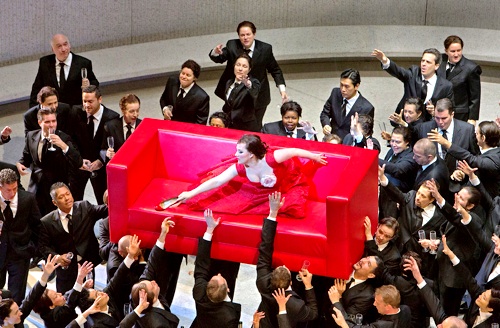By James Jorden
With one of my favorite opera productions returning to the Met tonight, I’ve been considering lately what makes Willy Decker’s Traviata so fine, so satisfying, and so worth a return visit.
Of course I am impressed and even moved by the deliberate rejection of sentimentality in the treatment of a very deeply emotional work, and, as I’ve said before, Decker’s take on the work is one of the few that clearly and thoughtfully addresses the story of “Marguerite Gauthier” (et. al.) as myth.
But it wasn’t until recently that another piece fell into place. One of the elements that most elevates the piece from “period” to something classical and universal is the use of modern costume. Now, at first this may seem paradoxical: doesn’t modern dress define the period as very specifically “now,” not something that could have happened “then” or might yet happen in the future?

Well, apparently not. I can’t quite explain why, but for some reason, when we see something happening recognizably “now,” we don’t think of that event happening in any specific time. “Now,” is seems, means “always.” In fact, it seems further than the only way to narrow down an event, to make it seem specifically of one time and no other, is to include a visual detail that recognizably removes it from the present: a cloche or a tricorne, an Hispano-Suiza or a calèche.
Setting a classic piece in modern dress for me neutralizes the sense of period and with it the expectation that what I am about to see is a representation of a reality that once existed. Instead, I feel that I am being presented with a completely created reality, a crafted, artificial reality if you will. It doesn’t matter if they did (e.g.) arranged marriages in 1600 or 1900 or 1975, I just accept that for the three hours I’m in the theater, I’m observing a world in which arranged marriages are a real thing.
I’m also not niggling over “is that corset cut correctly?” or “why in the name of heaven did they force that poor fellow with the skinny legs to wear pumpkin hose?” or “well, actually, no, a woman wearing a crinoline probably wouldn’t think it was such a good idea to throw herself on the bed quite so petulantly” or whatever.
What I like maybe even best about well-chosen modern dress for a classic piece is that essentially the costumes disappear and all you see are the actors. There can even still be character touches in the costumes (a more European cut on a suit for a more dashing character, e.g.) that still don’t call attention to themselves.
This notion of what I think I’ll call “the eternal now” happens to be reinforced by the trailer for, of all things, a new Joss Wheedon film:
Wheeldon reportedly shot this film during a two-week break from working on The Avengers. (We should all be so lucky to be so in flow that our vacation from doing our job is doing the same job on a smaller scale.) Of course, it’s hard to tell from a trailer how successfully an adaptation will play out in full length. But the idea that even in so conservative a medium as film, Shakespeare can now be done unapologetically and without special pleading in a purely modern setting I think speaks to the power of the “eternal now.”
And, in fact, modern dress is in sense more authentic for most period drama than actual period dress. Shakespeare was originally performed in a version of contemporary garb. Not just any old stuff from off the rack, of course, but what the actors wore were instantly recognizable as garments, silhouettes and fabrics derived from current fashion. This concept continued through the first third of the 19th century, at which point actor/directors began introducing “archeological” costume based more or less closely on historically documented dress.
Famously, Verdi wanted Traviata to be done in contemporary dress, but for various reasons he was overruled; I would suggest that one of those reasons was that the subject matter was so uncomfortably powerful that some means of distancing it had to be devised.
We’re thankfully some distance away from the rigid moral hypocrisies of the Victorian era (though even in the most enlightened segments of Western society, women are to to this day still subject to some rather quaint attitudes about sexuality), and so it seems it’s time we accept the risk of taking the theme of La traviata seriously, without the protective veil of “once upon a time.”
And that’s what Decker’s Traviata does, brilliantly. This staging is a monument to a progressive Metropolitan Opera and a model for continued modernization of the production repertoire.
The future of opera, one might say, is the Eternal Now.
Photo: Ken Howard/Metropolitan Opera.
Tags: peter gelb, regie, the eternal now, the met, traviata, willy decker